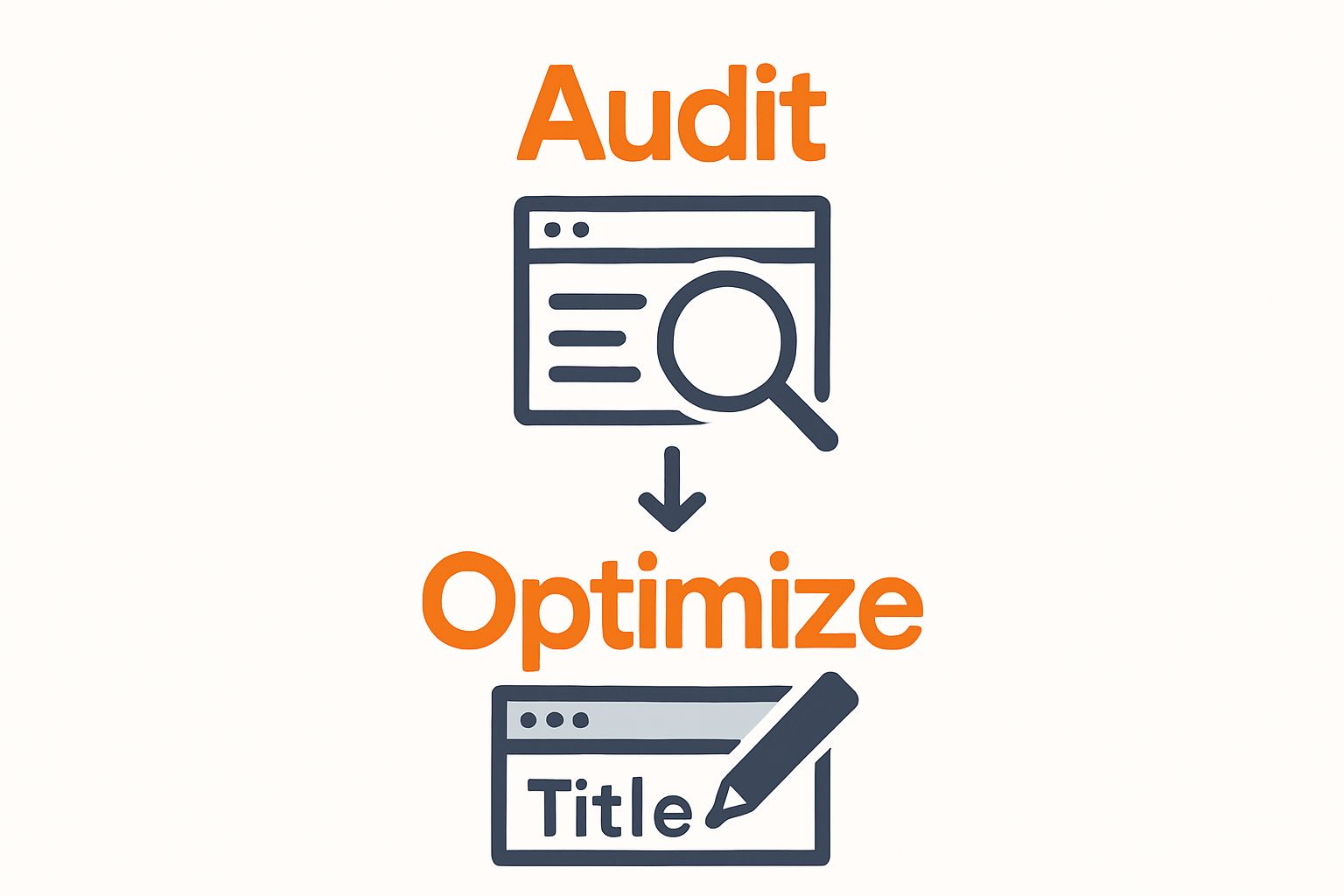Meta descriptions often seem like minor details, tucked away in the background of every website page. Yet research shows websites that optimize meta descriptions can see click-through rates increase by up to 30 percent just from this one tweak. The real surprise is most businesses overlook outdated or missing descriptions entirely and miss out on a huge opportunity to win more visitors—making smart optimization strategies far more powerful than people realize.
Table of Contents
- Step 1: Analyze Current Meta Descriptions For Effectiveness
- Step 2: Research Relevant Keywords For Your Business
- Step 3: Create Compelling And Informative Meta Descriptions
- Step 4: Implement Meta Descriptions On Your Website
- Step 5: Monitor And Adjust Meta Descriptions For Performance
Quick Summary
| Key Point | Explanation |
|---|---|
| 1. Conduct a thorough meta description audit | Review every page’s meta descriptions to assess their quality and relevance, identifying opportunities for improvement. |
| 2. Utilize effective keyword research | Identify relevant keywords aligned with user intent to enhance your meta descriptions and attract search engine visibility. |
| 3. Write compelling and unique descriptions | Craft engaging meta descriptions that accurately represent page content and encourage clicks, keeping them within the character limit. |
| 4. Implement meta descriptions strategically | Use appropriate methods for your platform to ensure unique and relevant descriptions for each page. |
| 5. Monitor and refine performance regularly | Analyze engagement and performance metrics to adjust meta descriptions as needed, keeping your strategy dynamic and effective. |
Step 1: Analyze Current Meta Descriptions for Effectiveness
Optimizing meta descriptions begins with a thorough examination of your current website content. Understanding your existing meta description strategy is crucial for improving search engine visibility and user engagement. Learn more about our SEO optimization approach to get a comprehensive view of digital marketing tactics.
Start by conducting a comprehensive audit of your website’s meta descriptions. This process involves systematically reviewing every page to assess the quality, relevance, and effectiveness of existing meta descriptions. Use professional SEO tools like Google Search Console or specialized crawling software to generate a complete inventory of your current meta descriptions.
While analyzing, pay attention to several critical elements. Look for meta descriptions that are missing entirely, as these represent immediate opportunities for improvement. Examine the length of existing descriptions to ensure they fall within the optimal range of 150 to 160 characters. Meta descriptions outside this range may get truncated in search results, potentially losing crucial messaging.
Assess the quality of your meta descriptions by evaluating their core components. Each description should clearly communicate the page’s content, include relevant keywords naturally, and provide a compelling reason for users to click. Ask yourself: Does this meta description accurately represent the page content? Would it motivate a user to learn more?
Key verification criteria for an effective meta description audit include:

- Completeness: Every page has a unique meta description
- Relevance: Descriptions match page content precisely
- Keyword integration: Strategic and natural keyword placement
- Clarity: Clear, concise messaging that encourages user engagement
During your analysis, document your findings systematically. Create a spreadsheet tracking page URLs, existing meta descriptions, and potential improvement areas. This document will serve as your roadmap for subsequent optimization efforts, allowing you to prioritize pages with the most significant potential for improvement.
Below is a checklist summarizing the key verification criteria you should use while auditing your current meta descriptions for quality and effectiveness.
| Audit Criteria | What to Check For |
|---|---|
| Completeness | Each page has a unique meta description |
| Relevance | Description precisely matches page content |
| Keyword Integration | Strategic, natural use of relevant keywords |
| Clarity | Messaging is clear and concise |
| Accurate Content Representation | Description gives a truthful summary of the page |
| Character Length | Between 150-160 characters (not truncated) |
| Compelling CTA | Encourages users to click and learn more |
Successful meta description analysis sets the foundation for enhanced search engine performance. By methodically reviewing and understanding your current approach, you create a strategic framework for more effective SEO optimization.
Step 2: Research Relevant Keywords for Your Business
Keyword research forms the critical foundation for crafting compelling meta descriptions that attract search engine and user attention.
Explore our comprehensive keyword research guide to understand the nuanced strategies behind effective digital visibility.
Begin by understanding your business’s core offerings and target audience. Put yourself in your potential customer’s mindset. What specific terms would they use when searching for your products or services? For cannabis and e-commerce businesses, this means diving deep into industry-specific language and customer search behaviors.
Start with broad seed keywords related to your core business offerings. For a cannabis dispensary, these might include terms like “cannabis products,” “local dispensary,” or “medical marijuana.” Utilize keyword research tools such as Google Keyword Planner, SEMrush, or Ahrefs to expand these initial terms into more specific long-tail keywords that capture user intent more precisely.
Analyze search volume and competition for each keyword. Focus on keywords with moderate search volume and lower competition, which offer the best opportunity for visibility. Pay special attention to keywords that demonstrate clear commercial or informational intent relevant to your specific business niche.
Key verification criteria for effective keyword research include:
- Relevance to your specific business offerings
- Sufficient monthly search volume
- Alignment with user search intent
- Manageable keyword difficulty
- Geographic and industry specificity
Consider the user’s perspective when selecting keywords. A cannabis retailer might prioritize keywords like “legal cannabis near me” or “premium CBD products” that reflect specific customer needs. The goal is not just to rank, but to connect with potential customers by understanding their exact search motivations.
Document your keyword findings in a structured spreadsheet, categorizing them by relevance, search volume, and potential application in meta descriptions. This systematic approach transforms keyword research from a theoretical exercise into a practical strategy for improving your digital marketing effectiveness.
Successful keyword research provides the linguistic foundation for meta descriptions that not only improve search engine rankings but also genuinely communicate your business’s unique value proposition.
Step 3: Create Compelling and Informative Meta Descriptions
Crafting meta descriptions is an art that combines strategic keyword placement with persuasive copywriting. Learn more about optimizing product page content to elevate your digital marketing approach.
Begin by transforming your keyword research into compelling narratives that speak directly to your target audience. Each meta description should function like a concise advertisement, capturing the essence of the page while enticing users to click. For cannabis and e-commerce businesses, this means balancing informative content with an engaging, conversational tone that reflects your brand’s unique personality.
Write meta descriptions that answer the fundamental user questions: What will they find on this page? Why should they click? Aim to create a clear value proposition within the 150-160 character limit. For a cannabis dispensary, this might mean highlighting product quality, selection, or unique service offerings that set you apart from competitors.
Incorporate your primary keywords naturally, avoiding forced or awkward phrasing. The description should read like a smooth, compelling invitation to learn more. Use active language that creates a sense of immediacy and excitement. Instead of generic statements, craft descriptions that speak directly to user needs and interests.
Key verification criteria for effective meta descriptions include:
- Accurate page content representation
- Clear and compelling messaging
- Strategic keyword integration
- Adherence to character length requirements
- Unique description for each page
Consider the user’s perspective with every description you create. A meta description for a product page should highlight specific benefits, unique features, or solving a particular problem. For service pages, focus on the transformative potential of your offerings. The goal is to create a micro-narrative that compels users to click and explore further.

Develop a consistent style guide for your meta descriptions to maintain brand voice across your website. This approach ensures that each description feels connected while still being uniquely tailored to its specific page. Regularly review and refine your descriptions, treating them as dynamic marketing tools that can be optimized over time.
Successful meta descriptions bridge the gap between search engine optimization and genuine user engagement, turning technical requirements into powerful marketing opportunities.
Step 4: Implement Meta Descriptions on Your Website
Implementing meta descriptions requires a strategic approach that combines technical precision with marketing creativity. Explore our comprehensive guide for website optimization to enhance your digital presence.
Choose the right implementation method based on your website’s content management system. For WordPress users, plugins like Yoast SEO or Rank Math offer straightforward meta description management. Ecommerce platforms such as Shopify and WooCommerce provide built-in fields for meta descriptions in their page and product settings. If you’re working with a custom website, you’ll need to manually edit the HTML head section.
For manual HTML implementation, add the meta description tag within the page’s head section. The standard format looks like this: . Ensure each page receives a unique description that accurately represents its specific content. Avoid duplicating meta descriptions across multiple pages, as this can negatively impact your search engine optimization efforts.
Systematically work through your website, implementing meta descriptions page by page. Start with high-traffic pages like your homepage, product categories, and key service pages. For cannabis and e-commerce businesses, prioritize pages that directly drive customer conversions. This methodical approach prevents overwhelming yourself while ensuring comprehensive coverage.
Key verification criteria for meta description implementation include:
- Unique description for each page
- Correct HTML placement
- Adherence to character length requirements
- Keyword relevance
- Accurate page content representation
Utilize website crawling tools like Screaming Frog or Google Search Console to verify your implementation.
Here is a table comparing popular tools and methods for researching and implementing meta descriptions, as discussed throughout the guide.
| Tool/Method | Purpose | Platform/Usage Scope |
|---|---|---|
| Google Search Console | Audit and monitor meta descriptions and performance | Universal, web-based |
| Screaming Frog | Site-wide crawl to identify missing or duplicate meta | Desktop, supports all site types |
| Yoast SEO / Rank Math | Manage meta descriptions on WordPress | WordPress plugins |
| Shopify / WooCommerce | Built-in meta description fields for implementation | E-commerce platforms |
| Google Keyword Planner | Identify keywords for optimal meta descriptions | Universal, web-based |
| SEMrush / Ahrefs | Advanced keyword research and competitive analysis | Universal, paid tools |
Consider creating a spreadsheet to track your implementation progress. Document each page’s URL, current meta description status, and implementation date. This tracking method ensures comprehensive coverage and provides a clear overview of your optimization efforts.
Successful meta description implementation transforms your website’s search engine visibility, turning technical optimization into a powerful marketing tool that attracts and engages potential customers.
Step 5: Monitor and Adjust Meta Descriptions for Performance
Monitoring meta description performance transforms your SEO strategy from a static implementation to a dynamic, responsive approach. Explore our advanced SEO tracking techniques to understand comprehensive digital marketing optimization.
Begin with establishing baseline metrics through Google Search Console and Google Analytics. These powerful tools provide critical insights into your meta descriptions’ click-through rates, search impressions, and overall search performance. Focus on key performance indicators such as average position, click-through rate (CTR), and user engagement metrics that reveal how effectively your meta descriptions attract potential customers.
Implement a systematic review process where you evaluate meta description performance quarterly. During these reviews, analyze which descriptions generate the highest engagement and which might need refinement. For cannabis and e-commerce businesses, pay special attention to product and category pages where minor description adjustments can significantly impact user attraction and conversion rates.
Develop a data-driven optimization approach by creating experimental variations of your meta descriptions. A/B testing allows you to compare different messaging strategies, helping you understand what resonates most with your target audience. Track the performance of each variation carefully, looking for subtle improvements in click-through rates and user engagement.
Key verification criteria for meta description performance monitoring include:
- Consistent quarterly performance reviews
- Tracking click-through rate changes
- Monitoring search engine ranking position
- Analyzing user engagement metrics
- Comparing performance across different page types
Utilize heat mapping and user behavior tools to gain deeper insights into how users interact with your search results. These tools can reveal nuanced information about which meta descriptions compel users to click and which might need strategic redesign. Look for patterns in user behavior that indicate the effectiveness of your current meta description approach.
Remember that meta description optimization is an ongoing process. The digital landscape continually evolves, and user search behaviors change rapidly. Stay adaptable and willing to experiment with your messaging. What works today might need refinement tomorrow, so maintain a proactive and flexible approach to your meta description strategy.
Successful performance monitoring transforms meta descriptions from static text into dynamic marketing tools that continuously adapt and improve your digital visibility.
Transform Your Meta Description Strategy Into Real Search Growth
Is your website lost in the noise because your meta descriptions are overlooked or missing the mark? In the article, you discovered how crucial it is to analyze your current meta descriptions, select the right keywords, and deliver persuasive copy that turns impressions into clicks. But tackling these technical steps without specialist support can feel overwhelming—especially with evolving SEO rules and the unique challenges in cannabis and e-commerce visibility.
For dispensaries and online retailers, your meta descriptions need to work harder than ever to drive organic growth and stand out on competitive category pages. Juiced Digital has nearly a decade of expertise in supercharging cannabis and e-commerce SEO. You can access up-to-date strategies and powerful optimization insights through our Ecommerce Category Page SEO Tips for Dispensaries and our latest Digital Marketing knowledge base.

Ready to turn your meta descriptions into powerful click-drivers? Discover how our tailored audits, industry-specific SEO strategies, and hands-on implementation services can propel your site to the top. Visit Juiced Digital today and see measurable improvements in organic traffic and local search visibility. Now is the moment to act—take your next step toward stronger results.
Frequently Asked Questions
What is the purpose of optimizing meta descriptions?
Optimizing meta descriptions helps improve search engine visibility and user engagement by providing clear and compelling summaries of webpage content that encourage users to click on search results.
How do I identify effective meta descriptions?
To identify effective meta descriptions, conduct an audit of your current descriptions focusing on completeness, relevance, keyword integration, and clarity. Aim for unique, concise messages that accurately represent the page content.
What are the best practices for crafting compelling meta descriptions?
Best practices for crafting meta descriptions include using strategic keyword placement, addressing user questions, maintaining a character limit of 150-160 characters, and creating a unique description for each page that reflects the brand’s voice.
How can I monitor the performance of my meta descriptions?
Monitor performance using tools like Google Search Console and Google Analytics to track click-through rates, search impressions, and user engagement metrics. Conduct quarterly reviews to assess and refine your meta descriptions based on performance data.
Recommended
- SEO for Product Pages: Essential 2025 Guide for Cannabis & Ecommerce – Digital PR Expert | Digital Marketing & Search Leaders
- Top 10 SEO Strategies to Boost Organic Traffic in 2024 – Digital PR Expert | Digital Marketing & Search Leaders
- Ecommerce Category Page SEO Tips for Dispensaries 2025 – Digital PR Expert | Digital Marketing & Search Leaders
- dynamic-content-megamenu-menuitem2650 – Digital PR Expert | Digital Marketing & Search Leaders



